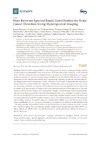Identificador persistente para citar o vincular este elemento:
https://accedacris.ulpgc.es/jspui/handle/10553/63426
| Título: | Most relevant spectral bands identification for brain cancer detection using hyperspectral imaging | Autores/as: | Martínez Vega, Beatriz León Martín, Sonia Raquel Fabelo Gómez, Himar Antonio Ortega, Samuel Piñeiro, Juan F. Zbigniew Szolna,Adam Hernandez, Maria Espino, Carlos O’shanahan, Aruma J. Carrera, David Bisshopp Alfonso, Sara Sosa Pérez, Coralia De Las Nieve Marquez, Mariano Camacho, Rafael de la Luz Plaza, Maria Morera, Jesus Marrero Callicó, Gustavo Iván |
Clasificación UNESCO: | 3314 Tecnología médica | Palabras clave: | Brain cancer Hyperspectral imaging Intraoperative imaging Feature selection Image-guided surgery, et al. |
Fecha de publicación: | 2019 | Proyectos: | Identificación Hiperespectral de Tumores Cerebrales (Ithaca) Plataforma H2/Sw Distribuida Para El Procesamiento Inteligente de Información Sensorial Heterogenea en Aplicaciones de Supervisión de Grandes Espacios Naturales Hyperspectral Imaging Cancer Detection (HELICoiD) |
Publicación seriada: | Sensors | Resumen: | Hyperspectral imaging (HSI) is a non-ionizing and non-contact imaging technique capable of obtaining more information than conventional RGB (red green blue) imaging. In the medical field, HSI has commonly been investigated due to its great potential for diagnostic and surgical guidance purposes. However, the large amount of information provided by HSI normally contains redundant or non-relevant information, and it is extremely important to identify the most relevant wavelengths for a certain application in order to improve the accuracy of the predictions and reduce the execution time of the classification algorithm. Additionally, some wavelengths can contain noise and removing such bands can improve the classification stage. The work presented in this paper aims to identify such relevant spectral ranges in the visual-and-near-infrared (VNIR) region for an accurate detection of brain cancer using in vivo hyperspectral images. A methodology based on optimization algorithms has been proposed for this task, identifying the relevant wavelengths to achieve the best accuracy in the classification results obtained by a supervised classifier (support vector machines), and employing the lowest possible number of spectral bands. The results demonstrate that the proposed methodology based on the genetic algorithm optimization slightly improves the accuracy of the tumor identification in ~5%, using only 48 bands, with respect to the reference results obtained with 128 bands, offering the possibility of developing customized acquisition sensors that could provide real-time HS imaging. The most relevant spectral ranges found comprise between 440.5–465.96 nm, 498.71–509.62 nm, 556.91–575.1 nm, 593.29–615.12 nm, 636.94–666.05 nm, 698.79–731.53 nm and 884.32–902.51 nm. | URI: | https://accedacris.ulpgc.es/handle/10553/63426 | ISSN: | 1424-8220 | DOI: | 10.3390/s19245481 | Fuente: | Sensors [1424-8220], v. 19 (24), artículo 5481 |
| Colección: | Artículos |
Citas SCOPUSTM
46
actualizado el 08-jun-2025
Citas de WEB OF SCIENCETM
Citations
45
actualizado el 18-ene-2026
Visitas
79
actualizado el 10-ene-2026
Descargas
60
actualizado el 10-ene-2026
Google ScholarTM
Verifica
Altmetric
Comparte
Exporta metadatos
Los elementos en ULPGC accedaCRIS están protegidos por derechos de autor con todos los derechos reservados, a menos que se indique lo contrario.
